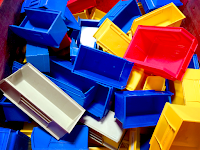By Elisha Burns, RAFT Fellow
This
is the time of the year when I think of all the things that I am thankful for
having in my life.
With all of the extra expenses that come with a teaching
career I am happy to learn of any ways to lessen my expenses. One of the
cost cutting resources that I love having access to as a teacher is RAFT. With
the dawn of Common Core and the push for project-based learning comes the need
for organizations like RAFT. As a teacher at a STEAM academy I am expected to
bring my lessons to life, however my school only provides me with a small
budget for materials.
 |
| Materials found at RAFT |
 Teachers
need to create dynamic hands on lessons and RAFT offers the resources necessary
to teach. Every time I come to RAFT I leave with a cart full of items and
ideas. I might find a stack of obsolete product boxes that become the
foundation for my student’s historical diorama. Walking around I might see a
display showing an innovative way to use corporate waste for learning. I find
the RAFT kits an excellent introduction to new topics or a great culminating
project to solidify concepts that have already been taught. Before the winter
holiday break I gave my students a chance to construct a holiday house that could
withstand the infamous RAFT shake table (shown below).
Teachers
need to create dynamic hands on lessons and RAFT offers the resources necessary
to teach. Every time I come to RAFT I leave with a cart full of items and
ideas. I might find a stack of obsolete product boxes that become the
foundation for my student’s historical diorama. Walking around I might see a
display showing an innovative way to use corporate waste for learning. I find
the RAFT kits an excellent introduction to new topics or a great culminating
project to solidify concepts that have already been taught. Before the winter
holiday break I gave my students a chance to construct a holiday house that could
withstand the infamous RAFT shake table (shown below).
These shake tables were made from
cardboard, PVC pipe, bottle caps, rubber balls and a small circuit. Alone these
items may seem like junk, but to my students it was just the exciting element
that they need to engage in their house construction.
Thank
goodness we have RAFT.

Comments
Post a Comment